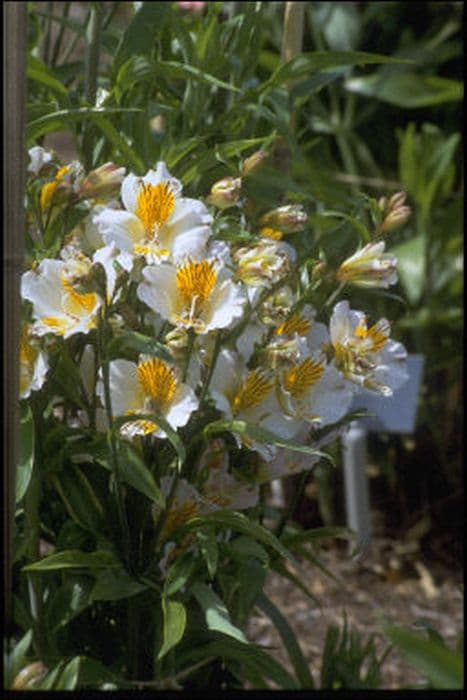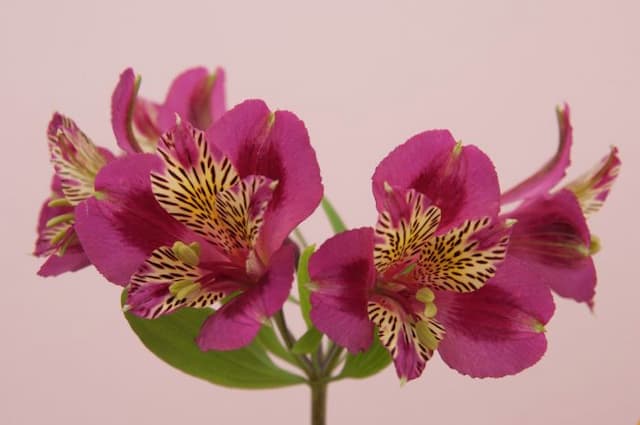Peruvian Lily Alstroemeria 'Red Beauty'

ABOUT
Alstroemeria 'Red Beauty' is renowned for its striking flowers that boast vibrant red petals, often adorned with intricate streaks or speckles in darker hues, typically in a contrasting color such as yellow or gold. Each blossom displays a symmetrical, lily-like shape that contributes to the plant's exotic and luxurious aesthetic. The flowers cluster at the tips of the stems, creating a lush bouquet appearance. The foliage underneath is typically dense, with narrow, lance-shaped leaves that extend from the stems, adding a verdant backdrop to the intense floral display. The overall visual effect of the Alstroemeria 'Red Beauty' is one of abundant color and vitality, making it a popular choice for garden enthusiasts seeking to add a dramatic flair to their outdoor spaces or cut flower arrangements.
About this plant
 Names
NamesFamily
Alstroemeriaceae
Synonyms
Peruvian Lily, Lily of the Incas, Parrot Lily
Common names
Alstroemeria 'Red Beauty'.
 Toxicity
ToxicityTo humans
The Peruvian Lily, known for its striking red flowers, is generally not considered highly toxic to humans. However, it can cause mild irritation if ingested. Handling the plant may sometimes result in dermatitis, an allergic skin reaction in sensitive individuals. If any parts of the Peruvian Lily are consumed, it may lead to gastrointestinal symptoms such as nausea, vomiting, or diarrhea. It is always best to avoid ingesting plants that are not meant for consumption to prevent any potential negative effects.
To pets
The Peruvian Lily is mildly toxic to pets. If pets, such as cats or dogs, ingest parts of the Peruvian Lily, they may experience mild gastrointestinal symptoms including vomiting or diarrhea. Typically, the plant is not known to cause severe reactions, but to ensure the well-being of pets, it is advisable to prevent them from accessing and ingesting the plant. If a pet ingests this plant and shows symptoms of distress, consulting a veterinarian is recommended.
 Characteristics
CharacteristicsLife cycle
Perennials
Foliage type
Deciduous
Color of leaves
Green
Flower color
Red
Height
2-3 feet (60-90 cm)
Spread
1-2 feet (30-60 cm)
Plant type
Bulb
Hardiness zones
7
Native area
South America
Benefits
 General Benefits
General Benefits- Vibrant Blossoms: Produces eye-catching, red flowers that add a splash of color to gardens and bouquets.
- Long Blooming Period: Offers a lengthy blooming season, from late spring to fall, providing prolonged visual interest.
- Easy to Grow: It is a low-maintenance plant, adapting to a range of garden conditions and often easy for beginners to cultivate.
- Attracts Pollinators: Serves as a food source for bees and butterflies, thus supporting local ecosystems.
- Drought Tolerance: Once established, it can tolerate periods of dryness, making it suitable for xeriscaping and water-wise gardens.
- Cut Flower Longevity: The blooms have a long vase life, often lasting up to two weeks, which is ideal for floral arrangements.
- Cold Hardy: Exhibits resilience to cooler temperatures and can survive in a variety of climates.
- Versatile Planting Options: Adept for planting in borders, containers, or as part of a flower bed, providing versatility in garden design.
- Propagates Easily: Can be easily propagated through division, allowing gardeners to create more plants for use in other areas or to share.
 Medical Properties
Medical PropertiesThis plant is not used for medical purposes.
 Air-purifying Qualities
Air-purifying QualitiesThis plant is not specifically known for air purifying qualities.
 Other Uses
Other Uses- Photography Prop: Alstroemeria 'Red Beauty', commonly known as Peruvian Lily, can be used as a stunning subject or backdrop for photography due to its vibrant red flowers and lush foliage.
- Educational Resource: The Peruvian Lily can be grown in school gardens to teach children about plant biology, cultivation, and the importance of pollinators in the ecosystem.
- Craft Material: The dried flowers and seed pods of the Peruvian Lily can be used in crafting, such as in making potpourri or decorative wreaths.
- Fashion Inspiration: The striking patterns and colors of the Peruvian Lily may inspire textile designs or fashion accessories.
- Culinary Presentation: The flowers can be used as an edible adornment to add color and a touch of elegance to desserts and cakes, after ensuring they're pesticide-free and safe for consumption.
- Event Decor: Peruvian Lily plants can be incorporated into live floral arrangements or centerpieces for events and celebrations to create a vibrant atmosphere.
- Botanical Art: The flowers and plants can be pressed and dried for use in botanical art, such as herbarium specimens or framed natural art pieces.
- Color Therapy: The bright red hue of the Peruvian Lily can be used in color therapy sessions for its potential to stimulate energy and passion, as red is often associated with these qualities.
- Garden Design: These plants can be used for their contrasting color in garden design, particularly in themed gardens that focus on a specific palette.
- Abstraction in Art: The unique form and coloration of Peruvian Lily blooms can be used by artists as a basis for abstract art pieces, capturing the essence of the flower in a more conceptual way.
Interesting Facts
 Feng Shui
Feng ShuiThe Peruvian Lily is not used in Feng Shui practice.
 Zodiac Sign Compitability
Zodiac Sign CompitabilityThe Peruvian Lily is not used in astrology practice.
 Plant Symbolism
Plant Symbolism- Friendship: Alstroemeria, commonly known as the Peruvian Lily or Lily of the Incas, symbolizes enduring friendship due to the flowers' interwoven petals representing the strong bonds between friends.
- Wealth, Prosperity, and Fortune: The lush appearance of the Peruvian Lily often signifies abundance, making it a symbol of wealth, prosperity, and good fortune in one's life.
- Devotion and Loyalty: The Peruvian Lily is a symbol of devotion and the steadfastness of one's loyalty, reflecting its ability to bloom throughout much of the year.
- Achievement and Success: With its vibrant blooms, it can be used to represent the achievement of personal goals and success.
- Mutual Support: Given as a gift, Peruvian Lilies can indicate mutual support and the willingness to help one another.
 Water
WaterPeruvian lilies, like the Alstroemeria 'Red Beauty', prefer consistent moisture and should be watered once the top inch of soil feels dry to the touch. This typically translates to watering every week, but may vary depending on climate and soil drainage. When watering, aim to provide enough water to soak the soil deeply, which would generally amount to about 1 to 2 gallons per plant for a mature Alstroemeria, encouraging root growth and plant health. During the growing season, especially in dry, hot spells, you may need to water more frequently. Conversely, in cooler months or when the plant is not actively growing, reduce watering to prevent waterlogged soil, which can cause root rot.
 Light
LightPeruvian lilies need bright, indirect sunlight to thrive. They perform best when placed in a location that receives several hours of morning sunlight with partial shade in the intense afternoon heat. An east-facing garden spot is ideal for providing the light conditions that the Alstroemeria 'Red Beauty' enjoys, balancing between adequate light for blooming and protection from harsh midday sun.
 Temperature
TemperatureThe ideal growing temperatures for Peruvian lilies, including the 'Red Beauty', range between 65 to 75 degrees Fahrenheit. They can survive minimum temperatures of 28 degrees Fahrenheit and maximum temperatures around 80 degrees Fahrenheit, but thrive in moderate conditions. Protection from extreme cold and heat is important to maintain healthy growth and flowering.
 Pruning
PruningPrune Peruvian lilies to encourage vigorous growth and abundant flowering. Deadhead spent blooms regularly to promote continuous blooming throughout the season. Cut flowers for arrangements at the base of the stem to stimulate the growth of new stems, which can be done as often as flowers are available and desirable. The best time for more extensive pruning is in the late autumn or early winter, after the plant has finished flowering and when you can cut back the foliage to ground level.
 Cleaning
CleaningAs needed
 Soil
SoilThe best soil mix for Peruvian Lily 'Red Beauty' should be well-draining, fertile, and loamy. A mixture consisting of two parts peat or coco coir, one part pine bark, and one part perlite or coarse sand works well. The ideal soil pH for Alstroemeria 'Red Beauty' is slightly acidic to neutral, around 6.0 to 7.0.
 Repotting
RepottingPeruvian Lilies should be repotted every 2-3 years or when the root system outgrows the current pot. It's best to repot in the spring as the plants emerge from dormancy to minimize stress and encourage robust growth during the growing season.
 Humidity & Misting
Humidity & MistingPeruvian Lily 'Red Beauty' thrives in moderate humidity levels, around 40-60%. If the indoor air is too dry, especially in winter, using a humidifier or placing a water tray nearby can help maintain these humidity conditions.
 Suitable locations
Suitable locationsIndoor
Ensure bright, indirect light and keep soil moist.
Outdoor
Plant in partial sun, shelter from strong winds.
Hardiness zone
7-10 USDA
 Life cycle
Life cycleThe Alstroemeria 'Red Beauty', commonly known as the Peruvian Lily or Lily of the Incas, begins its life as a dormant tuberous rhizome. Upon planting in well-draining soil and with the arrival of warmer temperatures, it breaks dormancy and sprouts foliage, followed by stalks that bear complex, trumpet-shaped flowers in vibrant red hues often streaked with darker colors. After flowering, which can last from late spring to fall, the plant undergoes a period of seed development, though many cultivars, including 'Red Beauty', are often sterile and propagated through division. As temperatures drop in autumn, the Peruvian Lily enters a state of dormancy, where above-ground growth dies back, and the plant conserves energy within its rhizomes. In its dormant state, it can withstand cooler temperatures and some neglect. With the return of favorable conditions in the next growing season, the cycle begins anew with new shoots emerging from the stored rhizomes.
 Propogation
PropogationPropogation time
Spring-Early Summer
The Alstroemeria, commonly known as the Peruvian Lily or Lily of the Incas, 'Red Beauty' variety is usually propagated through division, which is the most popular method. This process is best undertaken in late winter or early spring, just before the growing season commences. To propagate through division, carefully dig up an established clump of Alstroemeria 'Red Beauty' and gently separate the rhizomes by hand, ensuring that each division has at least one or two shoots and a portion of the root system. These divisions should then be replanted at a depth of approximately 6 to 8 inches (15 to 20 centimeters) and spaced about 12 to 18 inches (30 to 45 centimeters) apart to allow enough room for growth. Regular watering and light fertilization can help establish the new plants. It's important to handle the brittle roots carefully to avoid damage that could hinder the regrowth of the plants.





![Peruvian lily [H.R.H. Princess Alice]](/_next/image?url=https%3A%2F%2Fplants-admin.emdemapps.com%2Fimages%2Fplants%2F%2Fimages%2F604b55e81c8b0.png&w=640&q=75)

![Peruvian lily [Inca Coral]](/_next/image?url=https%3A%2F%2Fplants-admin.emdemapps.com%2Fimages%2Fplants%2F%2Fimages%2F604b5b79b85ce.png&w=640&q=75)
![Peruvian lily [Inca Exotica]](/_next/image?url=https%3A%2F%2Fplants-admin.emdemapps.com%2Fimages%2Fplants%2F%2Fimages%2F604b5ec0e34a9.png&w=640&q=75)
![Peruvian lily [Inca Milk]](/_next/image?url=https%3A%2F%2Fplants-admin.emdemapps.com%2Fimages%2Fplants%2F%2Fimages%2F604b5f14b0b6a.png&w=640&q=75)